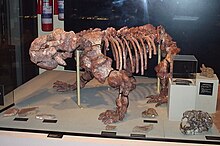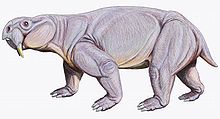Dinodontosaurus (meaning "terrible-toothed lizard") is a genus of dicynodont therapsid. It was medium to large dicynodont of the Triassic (with skull up to 40 centimetres (16 in) long[1]) and had a beak corneum. It lived in the Middle Triassic but disappeared in the Upper Triassic.
| Dinodontosaurus | |
|---|---|

| |
| Mounted Dinodontosaurus skeleton | |

| |
| D. tener illustration | |
| Scientific classification | |
| Domain: | Eukaryota |
| Kingdom: | Animalia |
| Phylum: | Chordata |
| Clade: | Synapsida |
| Clade: | Therapsida |
| Suborder: | †Anomodontia |
| Clade: | †Dicynodontia |
| Clade: | †Kannemeyeriiformes |
| Genus: | †Dinodontosaurus Romer, 1943 |
| Type species | |
| †Dinodontosaurus oliveirai Romer, 1943 [Junior synonym]
| |
| Species | |
| |
| Synonyms[1] | |
|
Genus synonymy
Species synonymy
| |
Species
edit- Dinodontosaurus tener is the most common species of dicynodont that existed in the Middle Triassic, and more common in the fossil layers that age in Rio Grande do Sul, in Rota Paleontológica. They are found mainly in the Paleontological Site Chiniquá in São Pedro do Sul and Candelária, where a group of ten pups were found together, demonstrating that these animals had strategies for coexistence in a group and caring for their offspring. Diodontosaurus pedroanum Tupi-Caldas, 1936 and Dinodontosaurus oliveirai, Romer 1943 are synonyms.[2]
- Dinodontosaurus brevirostris is known from remains found in Argentina. Chanaria platyceps Cox, 1968 and Dinodontosaurus platygnathus are synonyms.
Phylogeny
editDinodontosaurus in a cladogram from Szczygielski & Sulej (2023):[3]
Gallery
edit-
Skull (side)
-
Skull (front)
-
D. tener juveniles
References
edit- ^ a b Kammerer, C. F.; Ordoñez, M. D. (2021). "Dicynodonts (Therapsida: Anomodontia) of South America". Journal of South American Earth Sciences. 108: 103171. Bibcode:2021JSAES.10803171K. doi:10.1016/j.jsames.2021.103171. S2CID 233565963.
- ^ Paleobiology Database.
- ^ Szczygielski, T.; Sulej, T. (2023). "Woznikella triradiata n. gen., n. sp. – a new kannemeyeriiform dicynodont from the Late Triassic of northern Pangea and the global distribution of Triassic dicynodonts". Comptes Rendus Palevol. 22 (16): 279–406. doi:10.5852/cr-palevol2023v22a16.